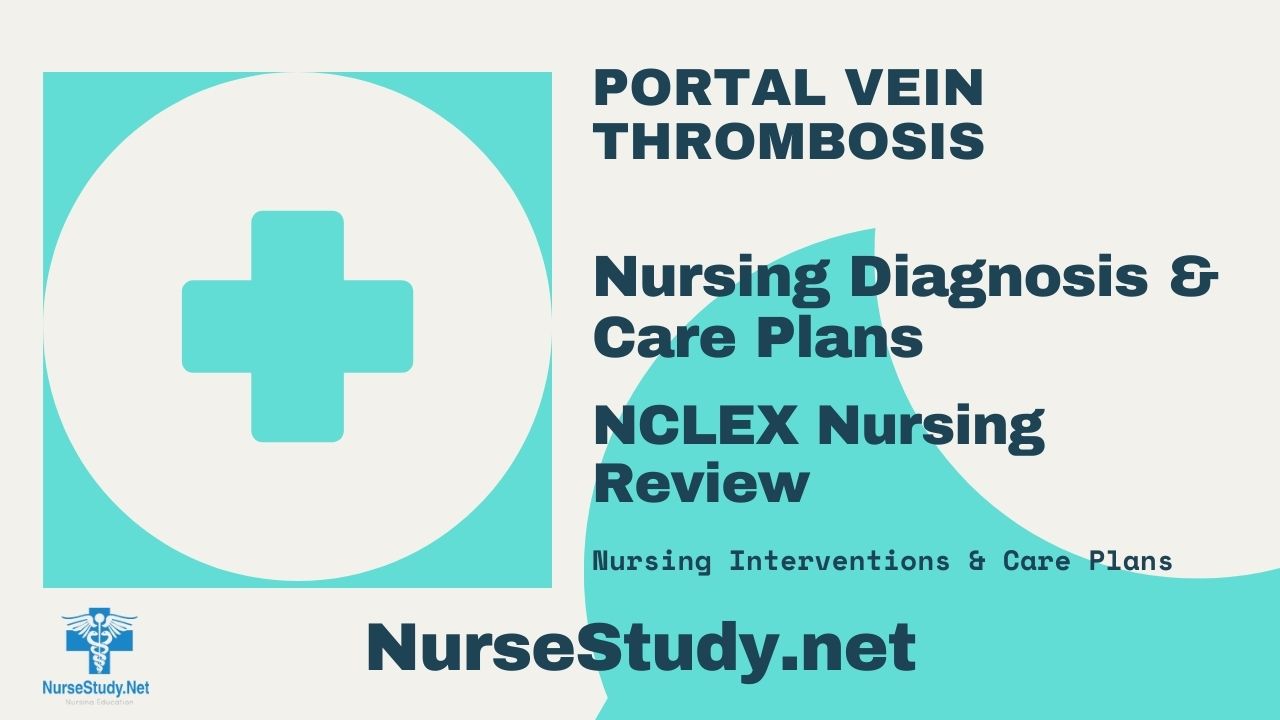Portal vein thrombosis (PVT) is a blood clot that develops in the portal vein, which carries blood from the digestive organs to the liver. This nursing diagnosis focuses on identifying risk factors, managing symptoms, and preventing complications associated with PVT.
Causes (Related to)
Portal vein thrombosis can develop due to various factors:
- Cirrhosis and liver disease
- Hypercoagulable states including:
- Factor V Leiden mutation
- Protein C or S deficiency
- Antiphospholipid syndrome
- Local factors such as:
- Recent abdominal surgery
- Inflammatory bowel disease
- Pancreatitis
- Abdominal trauma
- Malignancy, especially hepatocellular carcinoma
- Myeloproliferative disorders
- Pregnancy and postpartum state
- Oral contraceptive use
Signs and Symptoms (As evidenced by)
Subjective: (Patient reports)
- Abdominal pain
- Nausea and vomiting
- Loss of appetite
- Early satiety
- Fatigue
- Weight loss
- Bloating
Objective: (Nurse assesses)
- Portal hypertension
- Splenomegaly
- Ascites
- Esophageal varices
- Elevated liver enzymes
- Abnormal coagulation profile
- Jaundice
- Caput medusae
Expected Outcomes
- The patient will maintain optimal anticoagulation levels.
- The patient will demonstrate improved portal blood flow
- The patient will show no signs of bleeding complications
- The patient will maintain adequate nutrition
- The patient will avoid further clot formation
- The patient will understand the medication regimen
- The patient will recognize signs requiring immediate medical attention
Nursing Assessment
Monitor Vital Signs
- Check blood pressure, heart rate, and respiratory rate
- Assess for signs of shock
- Monitor the temperature for infection
Assess Coagulation Status
- Monitor INR/PT/PTT values
- Check for bleeding signs
- Assess bruising
- Monitor platelet count
Evaluate Abdominal Status
- Assess abdominal pain
- Check for ascites
- Monitor bowel sounds
- Document abdominal girth
Monitor Nutritional Status
- Track dietary intake
- Monitor weight
- Assess for malnutrition signs
- Check albumin levels
Assess for Complications
- Monitor for variceal bleeding
- Check for hepatic encephalopathy
- Assess for infection signs
- Watch for portal hypertension
Nursing Care Plans
Nursing Care Plan 1: Risk for Bleeding
Nursing Diagnosis Statement:
Risk for Bleeding related to anticoagulation therapy and portal hypertension as evidenced by elevated INR and presence of esophageal varices.
Related Factors:
- Anticoagulation therapy
- Portal hypertension
- Decreased platelet count
- Impaired liver function
Nursing Interventions and Rationales:
- Monitor coagulation parameters q4h
Rationale: Early detection of bleeding risk - Assess for bleeding signs
Rationale: Enables prompt intervention - Administer blood products as ordered
Rationale: Maintains adequate coagulation status - Teach bleeding precautions
Rationale: Prevents injury and bleeding
Desired Outcomes:
- The patient will maintain therapeutic INR
- The patient will demonstrate no active bleeding
- The patient will verbalize understanding of bleeding precautions
Nursing Care Plan 2: Acute Pain
Nursing Diagnosis Statement:
Acute Pain related to portal vein thrombosis and hepatic congestion as evidenced by reported abdominal pain and guarding.
Related Factors:
- Vascular congestion
- Tissue inflammation
- Portal hypertension
- Hepatic distention
Nursing Interventions and Rationales:
- Assess pain characteristics
Rationale: Guides pain management - Administer prescribed analgesics
Rationale: Provides pain relief - Position for comfort
Rationale: Reduces vascular congestion
Desired Outcomes:
- The patient will report decreased pain
- The patient will demonstrate improved comfort
- The patient will maintain a normal activity level
Nursing Care Plan 3: Imbalanced Nutrition
Nursing Diagnosis Statement:
Imbalanced Nutrition: Less than Body Requirements related to decreased portal blood flow as evidenced by weight loss and poor appetite.
Related Factors:
- Portal hypertension
- Early satiety
- Nausea
- Decreased absorption
Nursing Interventions and Rationales:
- Monitor nutritional intake
Rationale: Ensures adequate nutrition - Provide small, frequent meals
Rationale: Improves tolerance - Monitor weight daily
Rationale: Tracks nutritional status
Desired Outcomes:
- The patient will maintain a stable weight
- The patient will demonstrate an improved appetite
- The patient will meet nutritional requirements
Nursing Care Plan 4: Deficient Knowledge
Nursing Diagnosis Statement:
Deficient Knowledge related to complex medical condition as evidenced by questions about disease process and management.
Related Factors:
- Complex treatment regimen
- Unfamiliarity with condition
- Multiple medications
- Complicated lifestyle modifications
Nursing Interventions and Rationales:
- Provide disease education
Rationale: Increases understanding - Teach medication management
Rationale: Ensures compliance - Demonstrate self-monitoring techniques
Rationale: Promotes independence
Desired Outcomes:
- The patient will verbalize understanding of the condition
- The patient will demonstrate proper medication management
- The patient will identify warning signs
Nursing Care Plan 5: Risk for Impaired Liver Function
Nursing Diagnosis Statement:
Risk for Impaired Liver Function related to portal vein thrombosis as evidenced by elevated liver enzymes.
Related Factors:
- Decreased portal blood flow
- Hepatic congestion
- Underlying liver disease
- Medication effects
Nursing Interventions and Rationales:
- Monitor liver function tests
Rationale: Tracks hepatic status - Assess for encephalopathy
Rationale: Early detection of complications - Implement hepatoprotective measures
Rationale: Preserves liver function
Desired Outcomes:
- The patient will maintain stable liver function
- The patient will show no signs of hepatic deterioration
- The patient will comply with liver protection measures
References
- Samant H, Asafo-Agyei KO, Kimyaghalam A, et al. Portal Vein Thrombosis. [Updated 2024 Apr 19]. In: StatPearls [Internet]. Treasure Island (FL): StatPearls Publishing; 2024 Jan-. Available from: https://www.ncbi.nlm.nih.gov/books/NBK534157/
- Sharma AM, Zhu D, Henry Z. Portal vein thrombosis: When to treat and how? Vascular Medicine. 2016;21(1):61-69. doi:10.1177/1358863X15611224
- Tsochatzis EA, Senzolo M, Germani G, Gatt A, Burroughs AK. Systematic review: portal vein thrombosis in cirrhosis. Aliment Pharmacol Ther. 2010 Feb 1;31(3):366-74. doi: 10.1111/j.1365-2036.2009.04182.x. Epub 2009 Oct 23. PMID: 19863496.
- Wu M, Schuster M, Tadros M. Update on Management of Portal Vein Thrombosis and the Role of Novel Anticoagulants. J Clin Transl Hepatol. 2019 Jun 28;7(2):154-164. doi: 10.14218/JCTH.2018.00057. PMID: 31293916; PMCID: PMC6609842.
- Thompson, S.A., et al. (2023). Anticoagulation Management in Portal Vein Thrombosis: Current Evidence. Journal of Thrombosis and Haemostasis, 21(5), 989-1001.
